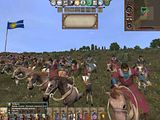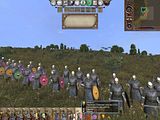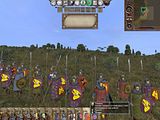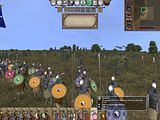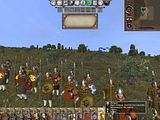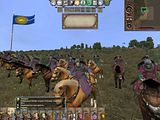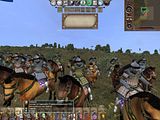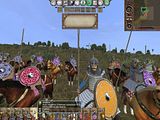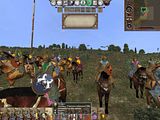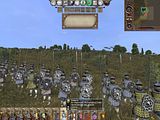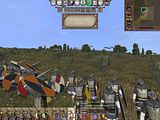The Khazars (Hebrew sing. "Kuzari" כוזרי plur. "Kuzarim" כוזרים; Turkish sing. "Hazar" plur. Hazarlar; Russian sing. Хазарин plur. Хазары; Tatar sing Xäzär plur. Xäzärlär; Crimean Tatar: sing. Hazar, plur. Hazarlar; Greek Χαζάροι/Χάζαροι; Persianخزر khazar; Latin "Gazari" or "Cosri") were a semi-nomadic Turkic people from Central Asia, many of whom converted to Judaism. The name 'Khazar' seems to be tied to a Turkic verb form meaning "wandering" ('gezer' in modern Turkish). In the 7th century CE they founded an independent Khaganate in the Northern Caucasus along the Caspian Sea, where over time Judaism became the state religion. At their height, they and their tributaries controlled much of what is today southern Russia, western Kazakhstan, eastern Ukraine, Azerbaijan, large portions of the Caucasus (including Dagestan, Georgia), and the Crimea.
They were important allies of the Byzantine Empire against the Sassanid Empire and later the Caliphate, the Pechenegs, and the Rus'. In later years, however, once Khazaria had become a significant regional power, the Byzantines abandoned the alliance and turned to the Rus' and Pechenegs against the Khazars. Between 965 and 969, their sovereignty was broken by Sviatoslav I of Kiev, and they became a subject people of Kievan Rus'. Gradually displaced by the Rus, the Kipchaks, and later the conquering Mongol Golden Horde, the Khazars largely disappeared as a culturally-distinct people.
Today, various place names invoking Khazar persist. Indeed, the Caspian Sea, traditionally known as the Hyrcanian Sea and Mazandaran Sea in Persian, came to be known to Iranians as the Khazar Sea as an alternative name.
Origins and prehistory
The origins of the Khazars are unclear. Following their conversion to Judaism, the Khazars themselves traced their origins to Kozar, a son of Togarmah. Togarmah is mentioned in Genesis in the Hebrew scriptures as a grandson of Japheth. It is unlikely, however, that he was regarded as an ancestor before the introduction of Biblical traditions to Khazaria.
Some historians have looked for possible connections between the Khazars and the lost tribes of Israel, but modern scholars generally consider them to be Turks who migrated from the East (and yet there are those who consider many Turkish peoples to be from the lost tribes of Israel as well). Scholars in the former USSR considered the Khazars to be an indigenous people of the North Caucasus. Some scholars, such as D.M. Dunlop, considered the Khazars to be connected with a Uyghur or Tiele confederation tribe called He'san in Chinese sources from the 7th-century (Suishu, 84). However, the Khazar language appears to have been an Oghuric tongue, similar to that spoken by the early Bulgars. Therefore, a Hunnish origin has also been postulated. Since the Turkic peoples were never ethnically homogenous, these ideas need not be deemed mutually exclusive. It is likely that the Khazar nation was made up of tribes from various ethnic backgrounds, as steppe nations traditionally absorbed those they conquered. Their name is accordingly derived from Turkic *qaz-, meaning "to wander, flee."
Armenian chronicles contain references to the Khazars as early as the late second century. These are generally regarded as anachronisms, and most scholars believe that they actually refer to Sarmatians or Scythians. Priscus relates that one of the nations in the Hunnish confederacy was called Akatziroi. Their king was named Karadach or Karidachus. Some, going on the similarity between Akatziroi and "Ak-Khazar" (see below), have speculated that the Akatziroi were early proto-Khazars.
Dmitri Vasil'ev of Astrakhan State University recently hypothesized that the Khazars moved in to the Pontic steppe region only in the late 500s, and originally lived in Transoxiana. According to Vasil'ev, Khazar populations remained behind in Transoxiana under Pecheneg and Oghuz suzerainty, possibly remaining in contact with the main body of their people.
Tribes
The Khazars' tribal structure is not well understood. They were divided between Ak-Khazars ("White Khazars") and Kara-Khazars ("Black Khazars"). Geographer Istakhri claimed that the White Khazars were strikingly handsome with reddish hair, white skin and blue eyes while the Black Khazars were swarthy verging on deep black as if they were "some kind of Indian". However, many Turkic nations had similar division between a "white" ruling warrior caste and a "black" class of commoners; the distinction is believed by most scholars to have had to do with race, though it is possible that this refers to the tan skin that developed in the lower working classes from working outside, and the height difference could be explained from the higher classed Khazars receiving better nutrition. The consensus among mainstream scholars is that Istakhri was himself confused by the name given to the two groups.
Rise
Formation of the Khazar state
Early Khazar history is intimately tied with that of the Göktürk empire, founded when the Ashina clan overthrew the Juan Juan in 552 CE. With the collapse of the Göktürk empire due to internal conflict in the seventh century, the western half of the Turk empire split into a number of tribal confederations, among whom were the Bulgars, led by the Dulo clan, and the Khazars, led by the Ashina clan, the traditional rulers of the Gok Turk empire. By 670, the Khazars had broken the Bulgar confederation, causing various tribal groups to migrate and leaving two remnants of Bulgar rule - Volga Bulgaria, and the Bulgarian khanate on the Danube River.
The first significant appearance of the Khazars in history is their aid to the campaign of the Byzantine emperor Heraclius against the Sassanid Persians. The Khazar ruler Ziebel (sometimes identified as Tong Yabghu Khagan of the West Turks) aided the Byzantines in overrunning Georgia. A marriage was even contemplated between Ziebel's son and Heraclius' daughter, but never took place. During these campaigns, the Khazars may have been ruled by Mo-ho-sad and their forces may have been under the command of his son Buri-sad.
During the 7th and 8th centuries the Khazar fought a series of wars against the Umayyad Caliphate, which was attempting simultaneously to expand its influence into Transoxiana and the Caucasus. The first war was fought in the early 650 and ended with the defeat of an Arab force led by Abd ar-Rahman ibn Rabiah outside the Khazar town of Balanjar, after a battle in which both sides used siege engines on the others' troops.
A number of Russian sources give the name of a Khazar khagan, Irbis, from this period, and describe him as a scion of the Göktürk royal house, the Ashina. Whether Irbis ever existed is open to debate, as is the issue of whether he can be identified with one of the many Göktürk rulers of the same name.
Several further conflicts erupted in the decades that followed, with Arab attacks and Khazar raids into Kurdistan and Iran. There is evidence from the account of al-Tabari that the Khazars formed a united front with the remnants of the Gok Turks in Transoxiana.
Khazars and Byzantium
Khazar overlordship over most of the Crimea dates back to the late 7th century. In the mid-8th century the rebellious Crimean Goths were put down and their city, Doros (modern Mangup) occupied. A Khazar tudun was resident at Cherson in the 690s, despite the fact that this town was nominally subject to the Byzantine Empire.
They are also known to have been allied with the Byzantine Empire during at least part of the eighth century. In 704/705 Justinian II, exiled in Cherson, escaped into Khazar territory and married the sister of the Khagan, Busir. With the aid of his wife, he escaped from Busir, who was intriguing against him with the usurper Tiberius III, murdering two Khazar officials in the process. He fled to Bulgaria, whose Khan Tervel helped him regain the throne. The Khazars later provided aid to the rebel general Bardanes, who seized the throne in 711 as Emperor Philippicus.
The Byzantine emperor Leo III married his son Constantine (later Constantine V Kopronymous) to the Khazar princess Tzitzak (daughter of the Khagan Bihar) as part of the alliance between the two empires. Tzitzak, who was baptized as Irene, became famous for her wedding gown, which started a fashion craze in Constantinople for a type of robe (for men) called tzitzakion. Their son Leo (Leo IV) would be better known as "Leo the Khazar".
Second Khazar-Arab war
Hostilities broke out again with the Caliphate in the 710s, with raids back and forth across the Caucasus but few decisive battles. The Khazars, led by a prince named Barjik, invaded northwestern Iran and defeated the Umayyad forces at Ardabil in 730, killing the Arab warlord al-Djarrah al-Hakami and briefly occupying the town. They were defeated the next year at Mosul, where Barjik directed Khazar forces from a throne mounted with al-Djarrah's severed head, and Barjik was killed. Arab armies led first by the Arab prince Maslamah ibn Abd al-Malik and then by Marwan ibn Muhammad (later Caliph Marwan II) poured across the Caucasus and eventually (in 737) defeated a Khazar army led by Hazer Tarkhan, briefly occupying Atil itself and possibly forcing the Khagan to convert to Islam. The instability of the Umayyad regime made a permanent occupation impossible; the Arab armies withdrew and Khazar independence was re-asserted. It has been speculated that the adoption of Judaism (which in this theory would have taken place around 740) was part of this re-assertion of independence.
It is worth noting that around 739, Arab sources give the name of the ruler of the Khazars as Parsbit or Barsbek, a woman who appears to have directed military operations against them. This suggests that women could have very high positions within the Khazar state, possibly even as a stand-in for the khagan.
Although they stopped the Arab expansion into Eastern Europe for some time after these wars, the Khazars were forced to withdraw behind the Caucasus. In the ensuing decades they extended their territories from the Caspian Sea in the east (many cultures still call the Caspian Sea "Khazar Sea"; e.g. "Xəzər dənizi" in Azeri, "Hazar Denizi" in Turkish, "Bahr ul-Khazar" in Arabic, "Darya-ye Khazar" in Persian) to the steppe region north of Black Sea in the west, as far west at least as the Dnieper River.
In 758, the Abbasid Caliph Abdullah al-Mansur ordered Yazid ibn Usayd al-Sulami, one of his nobles and military governor of Armenia, to take a royal Khazar bride and make peace. Yazid took home a daughter of Khagan Baghatur, the Khazar leader. Unfortunately, the girl died inexplicably, possibly in childbirth. Her attendants returned home, convinced that some Arab faction had poisoned her, and her father was enraged. A Khazar general named Ras Tarkhan invaded what is now northwestern Iran, plundering and raiding for several months. Thereafter relations between the Khazars and the Abbasid Caliphate (whose foreign policies were generally less expansionist than its Umayyad predecessor) became increasingly cordial.
Khazar religion
Turkic shamanism
Shamanism
Originally, the Khazars practiced traditional Turkic shamanism, focused on the sky god Tengri, but were heavily influenced by Confucian ideas imported from China, notably that of the Mandate of Heaven. The Ashina clan were considered to be the chosen of Tengri and the kaghan was the incarnation of the favor the sky-god bestowed on the Turks. A kaghan who failed had clearly lost the god's favor and was typically ritually executed. Historians have sometimes wondered, only half in jest, whether the Khazar tendency to occasionally execute their rulers on religious grounds led those rulers to seek out other religions.
The Khazars worshipped a number of deities subordinate to Tengri, including the fertility goddess Umay, Kuara, a thunder god, and Erlik, the god of death.
Conversion to Judaism and relations with world Jewry
Jewish communities had existed in the Greek cities of the Black Sea coast since late classical times. Chersonesos, Sudak, Kerch and other Crimean cities possessed Jewish communities, as did Gorgippia, and Samkarsh / Tmutarakan was said to have had a Jewish majority as early as the 670s. The original Jewish settlers were joined by waves of immigration fleeing persecution in the Byzantine Empire, Sassanid Persia (particularly during the Mazdak revolts), and later within the Islamic world. Jewish merchants such as the Radhanites regularly traded in Khazar territory, and may have wielded significant economic and political influence. Though their origins and history are somewhat unclear, the Mountain Jews also lived in or near Khazar territory and may have been allied with or subject to Khazar overlordship; it is conceivable that they too played a role in the conversion.
At some point in the last decades of the 8th century or the early 9th century, the Khazar royalty and nobility converted to Judaism, and part of the general population followed. The extent of the conversion is debated. Ibn al-Faqih reported in the 10th century that "all the Khazars are Jews." Notwithstanding this statement, some scholars believe that only the upper classes converted to Judaism; there is some support for this in contemporary Muslim texts. However, recent archeological excavations have uncovered widespread shifts in burial practices. Around the mid 800s burials in Khazaria began to take on a decidedly Jewish flavor. Grave goods disappeared almost altogether. Judging by interment evidence, by 950 Judaism had become widespread among all classes of Khazar society.
Essays in the Kuzari, written by Yehuda Halevi, detail a moral liturgical reason for the conversion which some consider a moral tale. Some researchers have suggested part of the reason for this mass conversion was political expediency to maintain a degree of neutrality: the Khazar empire was between growing populations, Muslims to the east and Christians to the west. Both religions recognized Judaism as a forebear and worthy of some respect. The exact date of the conversion is hotly contested. It may have occurred as early as 740 or as late as the mid 800s. Recently-discovered numismatic evidence suggests that Judaism was the established state religion by c. 830, and though St. Cyril (who visited Khazaria in 861) did not identify the Khazars as Jews, the khagan of that period, Zachariah, had a biblical Hebrew name. Some medieval sources give the name of the rabbi who oversaw the conversion of the Khazars as Isaac Sangari or Yitzhak ha-Sangari.
The first Jewish Khazar king was named Bulan which means "elk", though some sources give him the Hebrew name Sabriel. A later king, Obadiah, strengthened Judaism, inviting rabbis into the kingdom and building synagogues. Jewish figures such as Saadia Gaon made positive references to the Khazars, and they are excoriated in contemporary Karaite writings as "bastards"; it is therefore unlikely that they adopted Karaism as some (such as Avraham Firkovich) have proposed.
According to the Schechter Letter, early Khazar Judaism was centered on a mishkan similar to that mentioned in the Book of Exodus. Archaeologists at Rostov-on-Don have tentatively identified a folding altar unearthed at Khumar as part of such a construct.
The Khazars enjoyed close relations with the Jews of the Levant and Persia. The Persian Jews, for example, hoped that the Khazars might succeed in conquering the Caliphate. The high esteem in which the Khazars were held among the Jews of the Orient may be seen in the application to them, in an Arabic commentary on Isaiah ascribed by some to Saadia Gaon, and by others to Benjamin Nahawandi, of Isaiah 48:14: "The Lord hath loved him." "This," says the commentary, "refers to the Khazars, who will go and destroy Babel" (i.e., Babylonia), a name used to designate the country of the Arabs. From the Khazar Correspondence it is apparent that two Spanish Jews, Judah ben Meir ben Nathan and Joseph Gagris, had succeeded in settling in the land of the Khazars. Saadia, who had a fair knowledge of the kingdom of the Khazars, mentions a certain Isaac ben Abraham who had removed from Sura to Khazaria.
Likewise, the Khazar rulers viewed themselves as the protectors of international Jewry, and corresponded with foreign Jewish leaders (the letters exchanged between the Khazar ruler Joseph and the Spanish rabbi Hasdai ibn Shaprut have been preserved). They were known to retaliate against Muslim or Christian interests in Khazaria for persecution of Jews abroad. Ibn Fadlan relates that around 920 the Khazar ruler received information that Muslims had destroyed a synagogue in the land of Babung, in Iran; he gave orders that the minaret of the mosque in his capital should be broken off, and the muezzin executed. He further declared that he would have destroyed all the mosques in the country had he not been afraid that the Muslims would in turn destroy all the synagogues in their lands.
Some have speculated that Ashkenazic Jews are the descendants of the non-Semitic converted Khazars, but no genealogical records exist of Khazar ancestry to today’s Jews. Since Ashkenazi Jews make up the majority of world Jewry, such speculation is often held in conjunction with the belief that modern day Jews are not the true descendants of the Ancient Israelites, and that contemporary Jewry has no rightful claim to the land of the State of Israel. This thesis began to gain popularity among the Holocaust denial movement during the 20th century, especially after the establishment of Israel in 1948. It is also popular among groups such as the Black Hebrews, British Israelitists and others who claim Israelite descent and seek to downplay the connection between the Jewish people and their Israelite ancestors.
Other religions
Besides Judaism, other religions probably practiced in areas ruled by the Khazars include Greek Orthodox, Nestorian, and Monophysite Christianity, Zoroastrianism as well as Norse, Finnic, and Slavic cults. Religious toleration was maintained for the kingdom's three hundred plus years. The "apostle of the Slavs", Saint Cyril, is said to have attempted the conversion of Khazars without enduring results. Many Khazars reportedly were converts to Christianity and Islam. (See "Judiciary", below.)
Government
Khazar kingship
Khagan; Khagan Bek; for names of Khazar rulers see List of Khazar rulers.
Khazar kingship was divided between the khagan and the Bek or Khagan Bek. Contemporary Arab historians related that the Khagan was purely a spiritual ruler or figurehead with limited powers, while the Bek was responsible for administration and military affairs.
Both the Khagan and the Khagan Bek lived in Itil. The Khagan's palace, according to Arab sources, was on an island in the Volga River. He was reported to have 25 wives, each the daughter of a client ruler; this may, however, have been an exaggeration.
In the Khazar Correspondence, King Joseph identifies himself as the ruler of the Khazars and makes no reference to a colleague. It has been disputed whether Joseph was a Khagan or a Bek; his description of his military campaigns make the latter probable. A third option is that by the time of the Correspondence (c. 950-960) the Khazars had merged the two positions into a single ruler, or that the Beks had somehow supplanted the Khagans or vice versa.
Army
Khazar armies were led by the Khagan Bek and commanded by subordinate officers known as tarkhans. A famous tarkhan referred to in Arab sources as Ras or As Tarkhan led an invasion of Armenia in 758. The army included regiments of Muslim auxiliaries known as Arsiyah, of Khwarezmian or Alan extraction, who were quite influential. These regiments were exempt from campaigning against their fellow Muslims. Early Russian sources sometimes referred to the city of Khazaran (across the Volga River from Atil) as Khvalisy and the Khazar (Caspian) sea as Khvaliskoye. According to some scholars such as Omeljan Pritsak, these terms were East Slavic versions of "Khwarezmian" and referred to these mercenaries.
In addition to the Bek's standing army, the Khazars could call upon tribal levies in times of danger and were often joined by auxiliaries from subject nations.
Other officials
Settlements were governed by administrative officials known as tuduns. In some cases (such as the Byzantine settlements in southern Crimea), a tudun would be appointed for a town nominally within another polity's sphere of influence.
Other officials in the Khazar government included dignitaries referred to by ibn Fadlan as Jawyshyghr and Kundur, but their responsibilities are unknown.
Judiciary
Muslim sources report that the Khazar supreme court consisted of two Jews, two Christians, two Muslims, and a "heathen" (whether this is a Turkic shaman or a priest of Slavic or Norse religion is unclear), and a citizen had the right to be judged according to the laws of his religion. Some have argued that this configuration is unlikely, as a Beit Din, or rabbinical court, requires three members. It is therefore possible that as practitioners of the state religion, the Jews had three judges on the Supreme Court rather than two, and that the Muslim sources were attempting to downplay their influence. A Muslim or Christian court can function with only one or two judges.
Economic position
Trade
The Khazars occupied a prime trade nexus. Goods from western Europe travelled east to Central Asia and China and vice versa, and the Muslim world could only interact with northern Europe via Khazar intermediaries. The Radhanites, a guild of medieval Jewish merchants, had a trade route that ran through Khazaria, and may have been instrumental in the Khazars' conversion to Judaism.
No Khazar paid taxes to the central government. Revenue came from a 10% levy on goods transiting through the region, and from tribute paid by subject nations. The Khazars exported honey, furs, wool, millet and other cereals, fish, and slaves. D.M. Dunlop and Artamanov asserted that the Khazars produced no material goods themselves, living solely off of trade. This theory has been refuted by discoveries over the last half-century, which include pottery and glass factories.
Khazar coinage
The Khazars are known to have minted silver coins, called Yarmaqs. Many of these were imitations of Arab dirhems with corrupted Arabic letters. Coins of the Caliphate were in widespread use due to their reliable silver content. Merchants from as far away as China, Great Britain, and Scandinavia accepted them regardless of their inability to read the Arab writing. Thus issuing imitation dirhems was a way to ensure acceptance of Khazar coinage in foreign lands.
Some surviving examples bear the legend "Ard al-Khazar" (Arabic for "land of the Khazars"). In 1999 a hoard of silver coins was discovered on the property of the Spillings farm in the Swedish island of Gotland. Among the coins were several dated 837/8 CE and bearing the legend, in Arabic script, "Moses is the Prophet of God" (a modification of the Muslim coin inscription "Muhammad is the Prophet of God"). In "Creating Khazar Identity through Coins", Roman Kovalev postulated that these dirhems were a special commemorative issue celebrating the adoption of Judaism by the Khazar ruler Bulan.
Extent of influence
The Khazar Khaganate was, at its height, an immensely powerful state. The Khazar heartland was on the lower Volga and the Caspian coast as far south as Derbent. In addition, from the late 600s the Khazars controlled most of the Crimea and the northeast littoral of the Black Sea. By 800 Khazar holdings included most of the Pontic steppe as far west as the Dneiper and as far east as the Aral Sea (some Turkic history atlases show the Khazar sphere of influence extending well east of the Aral). During the Khazar-Arab war of the early 700s, some Khazars evacuated to the Ural foothills, and some settlements may have remained.
Khazar towns
Khazar towns included:
Along the Caspian coast and Volga delta: Atil; Khazaran; Samandar
In the Caucasus: Balanjar; Kazarki; Sambalut; Samiran
In Crimea and Taman region: Kerch (also called Bospor); Theodosia; Güzliev (modern Eupatoria); Samkarsh (also called Tmutarakan, Tamatarkha); Sudak (also called Sugdaia)
In the Don valley: Sarkel
A number of Khazar settlements have been discovered in the Mayaki-Saltovo region. On the Dnieper, the Khazars founded a settlement called Sambat, which was part of what would become the city of Kiev. Chernihiv is also thought to have started as a Khazar settlement.
Tributary and subject nations
Kabar rebellion and the departure of theMagyars
At some point in the ninth century (as reported by Constantine Porphyrogenitus) a group of three Khazar clans called the Kabars revolted against the Khazar government. Omeljan Pritsak and others have speculated that the revolt had something to do with a rejection of rabbinic Judaism; this is unlikely as it is believed that both the Kabars and mainstream Khazars had pagan, Jewish, Christian, and Muslim members. Pritsak maintained that the Kabars were led by the Khagan Khan-Tuvan Dyggvi in a war against the Bek. In any event Pritsak cited no primary source for his propositions in this matter. The Kabars were defeated and joined a confederacy led by the Magyars. It has been speculated that "Hungarian" derives from the Turkic word "Onogur", or "Ten Arrows", referring to seven Finno-Ugric tribes and the three tribes of the Kabars.
In the closing years of the ninth century the Khazars and Oghuz allied to attack the Pechenegs, who had been attacking both nations. The Pechenegs were driven westward, where they forced out the Magyars (Hungarians) who had previously inhabited the Don-Dnieper basin in vassalage to Khazaria. Under the leadership of the chieftain Lebedias and later Arpad, the Hungarians moved west into modern-day Hungary. The departure of the Hungarians led to an unstable power vacuum and the loss of Khazar control over the steppes north of the Black Sea.
Diplomatic isolation and military threats
The alliance with the Byzantines began to collapse in the early 900s, possibly as a result of the conversion to Judaism. Byzantine and Khazar forces may have clashed in the Crimea, and by the 940s Constantine VII Porphyrogentius was speculating in De Administrando Imperio about ways in which the Khazars could be isolated and attacked. The Byzantines during the same period began to attempt alliances with the Pechenegs and the Rus, with varying degrees of success.
From the beginning of the tenth century, the Khazars found themselves fighting on multiple fronts as nomadic incursions were exacerbated by uprisings by former clients and invasions from former allies, often at Byzantine instigation. According to the Schechter Text, the Khazar ruler Benjamin ben Menahem fought a war against a coalition of "'SY, TWRQY, 'BM, and PYYNYL," who were instigated and aided by "MQDWN". MQDWN or Macedon refers to the Byzantine Empire in many medieval Jewish writings; the other entities named have been tenuously identified by scholars including Omeljan Pritsak with the Burtas, Oghuz Turks, Volga Bulgars and Pechenegs, respectively. Though Benjamin was victorious, his son Aaron II had to face another Byzantine-inspired invasion, this time led by the Alans. Aaron defeated the Alans with Oghuz help, yet within a few years the Oghuz and Khazars were enemies.
Ibn Fadlan reported Oghuz hostility to the Khazars during his journey c. 921. Some sources, discussed by Tamara Rice, claim that Seljuk, the eponymous progenitor of the Seljuk Turks, began his career as an Oghuz soldier in Khazar service in the early and mid tenth century, rising to high rank before he fell out with the Khazar rulers and departed for Khwarazm.
Rise of Rus
Originally the Khazars were probably allied with various Norse factions who controlled the region around Novgorod. The Rus' Khaganate, an early Rus polity in northwestern Russia, was probably heavily influenced by the Khazars. The Rus' regularly travelled through Khazar-held territory to attack territories around the Black and Caspian Seas; in one such raid, the Khagan is said to have given his assent on the condition that the Rus' give him half of the booty. In addition, the Khazars allowed the Rus to use the trade route along the Volga River. This alliance was apparently fostered by the hostility between the Khazars and Arabs. At a certain point, however, the Khazar connivance to the sacking of the Muslim lands by the Varangians led to a backlash against the Norsemen from the Muslim population of the Khaganate. The Khazar rulers closed the passage down the Volga for the Rus', sparking a war. In the early 960s, Khazar ruler Joseph wrote to Hasdai ibn Shaprut about the deterioration of Khazar relations with the Rus: "I have to wage war with them, for if I would give them any chance at all they would lay waste the whole land of the Muslims as far as Baghdad."
The Rus warlords Oleg of Novgorod and Sviatoslav I of Kiev launched several wars against the Khazar khaganate, often with Byzantine connivance. The Schechter Letter relates the story of a campaign against Khazaria by HLGW (Oleg) around 941 (in which Oleg was defeated by the Khazar general Pesakh; this calls into question the timeline of the Primary Chronicle and other related works on the history of the Eastern Slavs.
Sviatoslav finally succeeded in destroying Khazar imperial power in the 960s. The Khazar fortresses of Sarkel and Tamatarkha fell to the Rus in 965, with the capital city of Atil following circa 967 or 969. A visitor to Atil wrote soon after the sacking of the city: "The Rus attacked, and no grape or raisin remained, not a leaf on a branch."
Khazars outside Khazaria
Khazar communities existed outside those areas under Khazar overlordship. Many Khazar mercenaries served in the armies of the Caliphate and other Islamic states. Documents from medieval Constantinople attest to a Khazar community mingled with the Jews of the suburb of Pera. Christian Khazars also lived in Constantinople, and some served in its armies. The Patriarch Photius I of Constantinople was once angrily referred to by the Emperor as "Khazar-face", though whether this refers to his actual lineage or is a generic insult is unclear.
Abraham ibn Daud reported Khazar rabbinical students, or rabbinical students who were the descendants of Khazars, in 12th century Spain. Jews from Kiev and elsewhere in Russia, who may or may not have been Khazars, were reported in France, Germany and England.
The Kabars who settled in Hungary in the late ninth and early tenth centuries may have included Jews among their number. Many Khazar Jews probably fled foreign conquest into Hungary and elsewhere in Eastern Europe. There they likely merged with local Jews and ensuing waves of Jewish immigration from Germany and Western Europe. They most likely did not constitute the dominant group within Eastern European Jewry, as Arthur Koestler maintained (see below).
Polish legends speak of Jews being present in Poland before the establishment of the Polish monarchy. Polish coins from the 12th and 13th centuries sometimes bore Slavic inscriptions written in the Hebrew alphabet though connecting these coins to Khazar influence is purely a matter of speculation.
Late references to the Khazars
There is debate as to the temporal and geographic extent of Khazar polities following Sviatoslav's sack of Atil in 967/9, or even whether any such states existed. The Khazars may have retained control over some areas in the Caucasus for another two centuries, but sparse historical records make this difficult to confirm.
The evidence of later Khazar polities includes the fact that Sviatoslav did not occupy the Volga basin after he destroyed Atil, and departed relatively quickly to embark on his campaign in Bulgaria. The permanent conquest of the Volga basin seems to have been left to later waves of steppe peoples like the Kipchaks.
Jewish sources
A letter in Hebrew dated AM 4746 (985–986) refers to "our lord David, the Khazar prince" who lived in Taman. The letter said that this David was visited by envoys from Kievan Rus to ask about religious matters — this could be connected to the Vladimir conversion which took place during the same time period. Taman was a principality of Kievan Rus around 988, so this successor state (if that is what it was) may have been conquered altogether. The authenticity of this letter, the Mandgelis Document, has however been questioned by such scholars as D. M. Dunlop.
Abraham ibn Daud, a twelfth-century Spanish rabbi, reported meeting Khazar rabbinical students in Toledo, and that they informed him that the "remnant of them is of the rabbinic faith." This reference indicates that some Khazars maintained ethnic, if not political, autonomy at least two centuries after the sack of Atil.
Petachiah of Ratisbon, a thirteenth-century rabbi and traveler, reported traveling through "Khazaria", though he gave few details of its inhabitants except to say that they lived amidst desolation in perpetual mourning.
He further related:
Whilst at Baghdad [i] saw ambassadors from the kings of Meshech, for Magog (medieval Christian writers said that the Khazars lived in the land of Gog and Magog) is about ten days' journey from thence. The land extends as far as the Mountains of Darkness (a term often used to describe the Caucasus). Beyond the Mountains of Darkness are the sons of Jonadab, son of Rechab (an official in the court of King Josiah of Judah). To the seven kings of Meshech an angel appeared in a dream, bidding them to give up the laws and statutes, and to embrace the laws of Moses, son of Amram. If not, he threatened to lay waste their country. However, they delayed until the angel commenced to lay waste their country, when the kings of Meshech and all the inhabitants of their countries became proselytes, and they sent to the head of the academy (i.e., the Gaon of Sura or Pumbedita) a request to send them some disciples of the wise. Every disciple that is poor goes there to teach them the law and Babylonian Talmud. From the land of Egypt the disciples go there to study. He saw the ambassadors visit the grave of [the prophet] Ezekiel…"
The account of the conversion of the "seven kings of Meshech" is extremely similar to the accounts of the Khazar conversion given in the Kuzari, and in King Joseph's Reply. It is possible that Meshech refers to the Khazars, or to some Judaized polity influenced by them. Arguments against this possibility include the reference to "seven kings" (though this, in turn, could refer to seven successor tribes or state micropolities).
Muslim sources
Ibn Hawqal and al-Muqaddasi refer to Atil after 969, indicating that it may have been rebuilt. Al-Biruni (mid-1000s) reported that Atil was in ruins, and did not mention the later city of Saqsin which was built nearby, so it is possible that this new Atil was only destroyed in the middle of the eleventh century. Even assuming al-Biruni's report was not an anachronism, there is no evidence that this "new" Atil was populated by Khazars rather than by Pechenegs or a different tribe.
Ibn al-Athir, who wrote around 1200, described "the raid of Fadhlun the Kurd against the Khazars". Fadhlun the Kurd has been identified as al-Fadhl ibn Muhammad al-Shaddadi, who ruled Arran and other parts of Azerbaijan in the 1030s. According to the account he attacked the Khazars but had to flee when they ambushed his army and killed 10,000 of his men. Two of the great early 20th century scholars on Eurasian nomads, Marquart and Barthold, disagreed about this account. Marquart believed that this incident refers to some Khazar remnant that had reverted to paganism and nomadic life. Barthold, (and more recently, Kevin Brook), took a much more skeptical approach and said that ibn al-Athir must have been referring to Georgians or Abkhazians. There is no evidence to decide the issue one way or the other.
Kievan Rus sources
According to the Primary Chronicle, in 986 Khazar Jews were present at Vladimir's disputation to decide on the prospective religion of the Kievian Rus. Whether these were Jews who had settled in Kiev or emissaries from some Jewish Khazar remnant state is unclear. The whole incident is regarded by a few radical scholars as a fabrication, but the reference to Khazar Jews (after the destruction of the Khaganate) is still relevant. Heinrich Graetz alleged that these were Jewish missionaries from the Crimea, but provided no reference to primary sources for his allegation.
In 1023 the Primary Chronicle reports that Mstislav (one of Vladimir's sons) marched against his brother Yaroslav with an army that included "Khazars and Kasogs". Kasogs were an early Circassian people. "Khazars" in this reference is considered by most to be intended in the generic sense, but some have questioned why the reference reads "Khazars and Kasogs", when "Khazars" as a generic would have been sufficient. Even if the reference is to Khazars, of course, it does not follow that there was a Khazar state in this period. They could have been Khazars under the rule of the Rus.
A Kievian prince named Oleg (not to be confused with Oleg of Kiev) was reportedly kidnapped by "Khazars" in 1078 and shipped off to Constantinople, although most scholars believe that this is a reference to the Kipchaks or other steppe peoples then dominant in the Pontic region. Upon his conquest of Tmutarakan in the 1080s Oleg gave himself the title "Archon of Khazaria".
Byzantine, Georgian and Armenian sources
Kedrenos documented a joint attack on the Khazar state in Kerch, ruled by Georgius Tzul, by the Byzantines and Russians in 1016. Following 1016, there are more ambiguous references in Eastern Christian sources to Khazars that may or may not be using "Khazars" in a general sense (the Byzantines and Arabs, for example, called all steppe people "Turks"; before them the Romans had called them all "Scythians"). Jewish Khazars were also mentioned in a Georgian chronicle as a group that inhabited Derbent in the late 1100s.
At least one 12th-century Byzantine source refers to tribes practicing Mosaic law and living in the Balkans; see Khalyzians. The connection between this group and the Khazars is rejected by most modern Khazar scholars.
Western sources
Giovanni di Plano Carpini, a thirteenth century Papal legate to the court of the Mongol Khan Guyuk, gave a list of the nations the Mongols had conquered in his account. One of them, listed among tribes of the Caucasus, Pontic steppe and the Caspian region, was the "Brutakhi, who are Jews." The identity of the Brutakhi is unclear. Giovanni later refers to the Brutakhi as shaving their heads. Though Giovanni refers to them as Kipchaks, they may have been a remnant of the Khazar people. Alternatively, they may have been Kipchak converts to Judaism (possibly connected to the Krymchaks or the Crimean Karaites).
Debate
Date and extent of the conversion
The date of the conversion, and whether it occurred as one event or as a sequence of events over time, is widely disputed. The issues surrounding this controversy are discussed above.
The number of Khazars who converted to Judaism is also hotly contested. D.M. Dunlop was of the opinion that only the upper class converted; this was the majority view until relatively recently. Analysis of recent archaeological grave evidence by such scholars as Kevin A. Brook asserts that the sudden shift in burial customs, with the abandonment of pagan-style burial with grave goods and the adoption of simple shroud burials during the mid 800s suggests a more widespread conversion.
Alleged Khazar ancestry of Ashkenazim
The theory that Ashkenazi Jews might be descended from Khazars (rather than Semitic groups) dates back to the late nineteenth century. It was first publicly proposed in lecture given by Ernest Renan on January 27, 1883, titled "Judaism as a Race and as Religion." It was repeated in articles in The Dearborn Independent in 1923 and 1925, and popularized by racial theorist Lothrop Stoddard in a 1926 article in the Forum titled "The Pedigree of Judah", where he argued that Ashkenazi Jews were a mix of people, of which the Khazars were a primary element. Stoddard's views were "based on nineteenth and twentieth-century concepts of race, in which small variations on facial features as well as presumed accompanying character traits were deemed to pass from generation to generation, subject only to the corrupting effects of marriage with members of other groups, the result of which would lower the superior stock without raising the inferior partners." This theory was adopted by British Israelites, who saw it as a means of invalidating the claims of Jews (rather than themselves) to be the true descendants of the ancient Israelites, and was supported by early anti-Zionists.
In 1951 Southern Methodist University professor John O. Beaty published The Iron Curtain over America, a work which claimed that "Khazar Jews" were "responsible for all of America's - and the world's - ills beginning with World War I". The book repeated a number of familiar antisemitic claims, placing responsibility for U.S. involvement in World Wars I and II and the Bolshevik revolution on these Khazars, and insisting that Khazar Jews were attempting to subvert Western Christianity and establish communism throughout the world. The American millionaire J. Russell Maguire gave money towards its promotion, and it was met with enthusiasm by hate groups and the extreme right. By the 1960s the Khazar theory had become a "firm article of faith" amongst Christian Identity groups. In 1971 Glubb Pasha also took up this theme, insisting that Palestinians were more closely related to the ancient Judeans than were Jews. According to Benny Morris:
Of course an anti-Zionist (as well as an anti-Semitic) point is being made here: The Palestinians have a greater political right to Palestine than the Jews do, as they, not the modern-day Jews, are the true descendants of the land's Jewish inhabitants\owners.
The theory gained further support when the novelist Arthur Koestler devoted his popular book The Thirteenth Tribe (1976) to the topic. Koestler's historiography has been attacked as highly questionable by many historians; it has also been pointed out that his discussion of theories about Ashkenazi descent is largely unsupported; to the extent that Koestler referred to place-names and documentary evidence his analysis has been described as a mixture of flawed etymologies and misinterpreted primary sources. Commentors have also noted that Koestler mischaracterized the sources he cited, particularly D.M. Dunlop's History of the Jewish Khazars (1954).
Koestler himself was emphatically pro-Zionist based on secular considerations, and did not see alleged Khazar ancestry as diminishing the claim of Jews to Israel, which he felt was based on the United Nations mandate, and not on Biblical covenants or genetic inheritance. In his view, "The problem of the Khazar infusion a thousand years ago ... is irrelevant to modern Israel". In addition, he was apparently "either unaware of or oblivious to the use anti-Semites had made to the Khazar theory since its introduction at the turn of the century." Nevertheless, in the Arab world the Khazar theory has been adopted by anti-Zionists and anti-Semites; such proponents argue that if Ashkenazi Jews are primarily Khazar and not Semitic in origin, they would have no historical claim to Israel, nor would they be the subject of the God's Biblical promise of Canaan to the Israelites, thus undermining the theological basis of both Jewish religious Zionists and Christian Zionists. In the 1970s and 80s the Khazar theory was also advanced used by some Russian chauvinist antisemites, particularly the historian Lev Gumilyov, who portrayed "Judeo-Khazars" as having repeatedly sabotaged Russia's development since the 7th century.
No modern mainstream scholars support this hypothesis. As Bernard Lewis writes:
This theory… is supported by no evidence whatsoever. It has long since been abandoned by all serious scholars in the field, including those in Arab countries, where the Khazar theory is little used except in occasional political polemics.
Other claims of descent
Others have claimed Khazar origins for such groups as the Karaim, Krymchaks, Mountain Jews, and Georgian Jews. There is little evidence to support any of these theories, although it is possible that some Khazar descendants found their way into these communities. Non-Jewish groups who claim at least partial descent from the Khazars include the Kumyks and Crimean Tatars; as with the above-mentioned Jewish groups, these claims are subject to a great deal of controversy and debate.
Genetic testing and DNA evidence
Recent DNA studies on the Y-Chromosome of Ashkenazi Jews showed they had an "extremely close affinity [with] non-Jewish Middle Eastern populations", indicating "a common Middle Eastern origin", as does the mitochondrial DNA (mtDNA) of at least 40% of the current Ashkenazi population. So although Khazars might have been absorbed into the Jewish population it is unlikely that they formed a large percentage of the ancestors of modern Ashkenazim.
In fiction
Khazars in fiction
The question of mass religious conversion is a central theme in Milorad Pavić's international bestselling novel Dictionary of the Khazars. The novel, however, contained many invented elements and had little to do with actual Khazar history. More recently, several novels, including H.N. Turteltaub's Justinian (about the life of Justinian II) and Marek Halter's Book of Abraham and Wind of the Khazars have dealt either directly or indirectly with the topic of the Khazars and their role in history.
In 2007, the New York Times Magazine serialized a novel by Michael Chabon entitled Gentlemen of the Road which features 10th century Khazar characters.









 Reply With Quote
Reply With Quote












































































